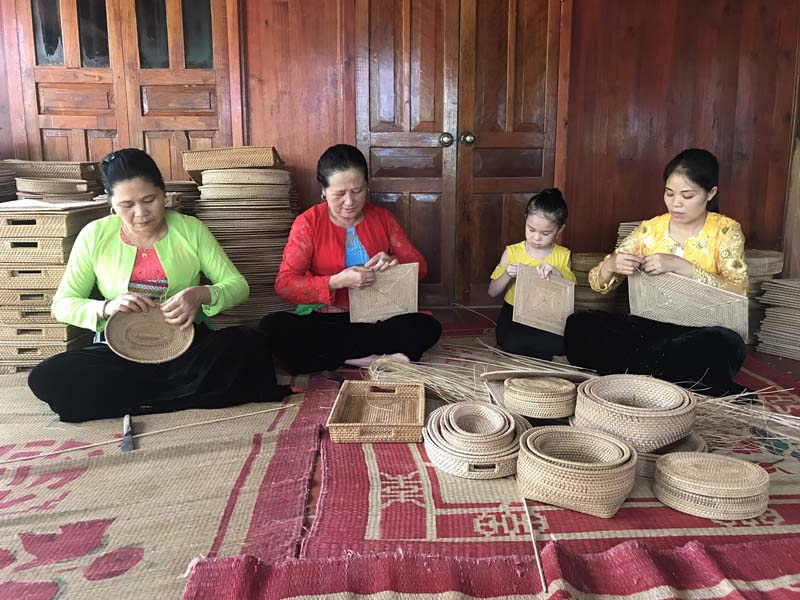
(HBO) - Rattan and bamboo weaving in Bui hamlet of Nhan Nghia commune (Lac Son district) dates back hundreds of years. Over generations, local craftsmen have always worked hard to ensure sophistication and uniqueness of each product.
Bamboo weaving sustained in Bui hamlet.
Well aware of the importance of the trade to economic
development and cultural identity conservation, local authorities have been
striving to gradually revive this traditional craft, thereby helping to reduce
poverty, improve income and create jobs for rural residents.
The rattan and bamboo craft village of Bui
hamlet, officially recognised on December 17, 2017, is providing stable jobs
for more than 350 locals with an average per capita income of 2 – 3 million VND
(86.4 – 129.5 USD) each month. It has been operating fruitfully, producing
items, mostly handmade, with diverse designs and ensured quality. As a result,
local products have won preference in the market, and the village has received
a number of big orders from across Vietnam, as well as other countries like
China and Japan.
Quach Thi Dung, head of the rattan and bamboo
craft village of Bui hamlet said: "This traditional craft village dates back to
a long time ago, but it used to fall into oblivion. I and other people have
strived to revitalise the traditional craft. The first steps were very
difficult, but thanks to the support of authorities of all levels, the rattan
and bamboo craft village was set up. It has attracted 170 households with over
350 workers to producing rattan and bamboo items. There remain numerous
difficulties in production development such as those relating to materials,
kilns, bleaching facilities, cutting machines and other equipment. We hope that
authorities will create more favourable conditions for the village to further develop.”
In the face of changes in the modern life,
rattan and bamboo weaving was sometimes thought to be unable to survive. Thanks
to their enthusiasm and dedication, the skilled craftsmen have been determined
to maintain this craft with the hope of seeking a firm foothold for it.
Bui Thi Thu Dung, a member at the rattan and
bamboo craft village of Bui hamlet said: "I began making rattan and bamboo
items when I was a small girl. My grandmother and mother taught me this craft.
I weave products to make use of my spare time and also raise my family’s
income.”
It takes craftsmen lots of steps and meticulousness to create a rattan and bamboo
item. Through their skilful hands, simple materials are transformed into fine
and colourful products imbued with cultural identities.
In the past, rattan and bamboo goods were made
mainly to serve daily needs of families. Recently, authorities of Nhan Nghia
commune have organised training courses to help craftsmen create new products
to meet the market’s rising demand such as flower baskets, lampshades or candy
containers with diverse designs.
Bui Duc Ngu, Chairman of the People’s Committee
of Nhan Nghia commune said: "Rattan and bamboo weaving has greatly contributed
to socio-economic development of the commune because it is a local traditional
craft which every people, from the elderly to teenagers, can practice, thus
helping to improve their income during their idle time. More and more people
have engaged in this craft.”
To maintain the rattan and bamboo weaving craft
of Bui hamlet, it is necessary to continue improving craftsmen’s skills, equip
them with modern machinery to better product quality and design, expand the
market and enhance products’ competitiveness so that the traditional craft is
conserved and developed, and the standing of traditions is further consolidated
in the modern life./.
The clothing of women reflects the culture of the Muong, Thai, Tay, Dao, and Mong ethnic groups in the northern province of Hoa Binh.
Gongs hold a special place in the cultural and spiritual life of the Muong ethnic people in Hoa Binh province. More than musical instruments, they are an indispensable part of community rituals and collective memory, echoing through generations as a spiritual thread linking the past, present, and future.
Preserving and promoting the cultural values of the Muong ethnic group has become an urgent task in the current context, as many traditional values face the risk of fading away. This effort requires not only protecting the cultural identity but also eliminating outdated customs and developing a modern cultural lifestyle, contributing to sustainable values for the Muong community in Hoa Binh province.
The Muong ethnic culture, deeply rooted in Vietnam’s mountainous north, continues to be preserved and revitalised by dedicated individuals and communities determined to safeguard their ancestral identity.
The Muong group is one of the largest ethnic minorities in Vietnam, primarily found in Hoa Binh province. The Muong people in Hoa Binh boast a rich and diverse cultural treasure that reflects the unique identity of this ethnic group. Accounting for over 63% of the province's population, they have created and preserved numerous distinctive cultural values, contributing to their unique identity. Their cultural heritage is an invaluable asset, at the heart of their national identity, and represents a vibrant spiritual life that must be preserved and promoted in today’s modern world.
For generations, the ethnic communities of Hoa Binh province, particularly the Muong people, have preserved vibrant festivals deeply intertwined with the region’s geography, nature, and social traditions. These celebrations enrich Hoa Binh’s spiritual life and cultural identity, reflecting both folk beliefs and the intermingling of ethnic customs. Many of these festivals have endured the test of time, passed down through generations and continuing to thrive today. Among them, the Khai Ha (Going Down to the Field) festival stands out as one of the most significant events of the Muong ethnic group.



